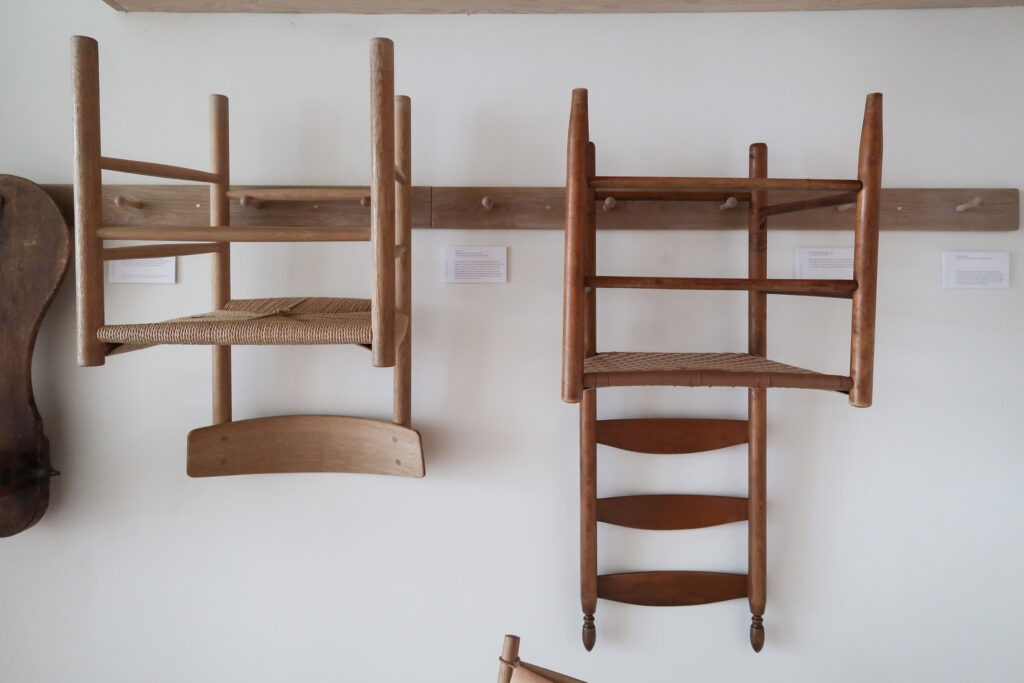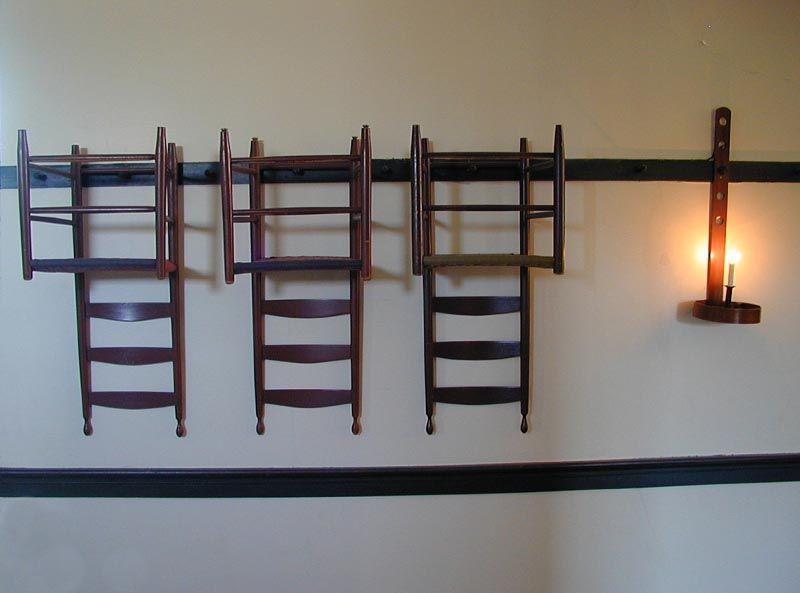
You’ve probably seen it in photos or movies – Amish chairs hung on walls. It’s not just for show. This tradition has a rich history with practicality, symbolism, and a unique way of life.
The Amish hang chairs on walls as a symbol of simplicity and community. This practice saves space in modest homes and underscores communal values, reflecting their lifestyle of humility and the importance of family and tradition.
Let’s dig deeper into how this unique practice of hanging chairs on walls reveals Amish values, shaping their lifestyle and family bonds.
The Tradition of Hanging Chairs Among the Amish
The unique Amish tradition of hanging chairs on walls became a practical solution in response to Amish homes’ modest and efficient living spaces. This space-saving method allowed for a versatile living environment for Amish families. It was necessary to clear floor space for daily activities and large gatherings in their typically smaller homes.
Evolution into a Cultural Emblem
As time progressed, this utilitarian practice became a significant cultural symbol within the Amish community. What started as a mere space-saving technique grew to represent the Amish dedication to a life of plainness and purpose.
Each hung chair transcended its functional role, symbolizing the Amish ethos: a commitment to living without excess and ensuring every home item had purpose and significance.
Craftsmanship and Symbolism
In Amish culture, chairmaking is a craft and an art form revered for expressing traditional carpentry skills. Each chair is a testament to Amish woodworking mastery and craftsmanship excellence.
Hanging these chairs is a tribute to these values, showcasing their practical approach to life and deep respect for their cultural heritage.
Expressions of Values and Community
In an Amish household, the chairs on the walls are more than mere decorations; they represent a tapestry of values, history, and community spirit. These chairs are silent yet powerful reminders of the Amish resilience – their ability to adapt and innovate practical solutions for everyday challenges.
The Art of Hanging: Safety and Ingenuity

The techniques used to hang these chairs are a testament to Amish ingenuity and attention to safety. Using traditional methods, often involving hand-forged hooks or wooden pegs, the Amish ensure that the chairs are hung securely.
This reflects their carpentry skills, relevance, and adaptability evolution in a changing world.
A Living Tradition
Today, the tradition of hanging chairs on Amish walls vividly illustrates a lifestyle that harmoniously blends functionality with meaning. It encapsulates the essence of Amish life, where practicality is seamlessly intertwined with deep-rooted values and beliefs.
As this tradition endures, it continues to be a vibrant portrayal of the Amish commitment to a life that balances the pragmatic with the symbolic, the ordinary with the extraordinary.
Practical Reasons Behind Hanging Chairs
There’s a good measure of practicality in the Amish tradition of hanging chairs on the wall. But it’s not just about saving space and utility; the aesthetic appeal and ease of maintaining cleanliness also play significant roles in this practice.
Space-saving Considerations
In the compact and multi-functional spaces of Amish homes, where rooms often serve multiple purposes, hanging chairs on the wall is not just common but a clever space-saving strategy.
This method is particularly effective in conserving valuable floor space, allowing for the easy transformation of a room to suit various daily activities and communal gatherings.

Amish carpentry, celebrated for its strength and durability, is crucial in this practice. Chairs are meticulously crafted to withstand the demands of being hung and removed frequently, reflecting a deep understanding of form and function.
Equally important in this practice is the consideration of wall durability. Amish carpenters ensure that the walls are fortified to bear the weight of the chairs without compromising their structural integrity.
Safety is a priority in this tradition. The Amish community, placing a high value on the well-being of its members, adopts meticulous safety measures to ensure that the hanging and removal of chairs are efficient and secure.
Aesthetic and Decorative Aspects
The wall aesthetics are enhanced by chair designs, often featuring intricate, decorative patterns. These chairs aren’t just furniture but pieces of art that reflect the community’s cultural heritage and individual craftsmanship.
They’re arranged thoughtfully to create interior harmony and a sense of belonging. The Amish take pride in their homes, and how they display their chairs is no exception.
Maintenance and Cleanliness
In addition to enhancing their home’s aesthetics, the Amish people hang chairs on the wall for practical reasons like maintenance and cleanliness.
This tradition aids dust prevention by keeping the chairs off the floor, reducing dust accumulation. This practice also serves as a pest control, minimizing the risk of critters nesting in the furniture.
Hanging chairs promotes furniture preservation and chair longevity, as it prevents undue wear and tear. It also makes cleaning easier. All you’ve got to do is take the chair down, clean it, and hang it back up.
Cultural and Symbolic Significance

Hanging chairs on the wall has deep cultural and symbolic significance within the Amish community. It’s not just about practicality; it reflects their religious beliefs, lifestyle, rituals, and ceremonies.
Religious Beliefs and Values
Every aspect of life allows the Amish to express their devout principles. Hanging chairs is a daily visual manifestation of this philosophy. It’s a practice that speaks volumes about their commitment to a humble existence.
In Amish homes, chairs are not just furniture but subtle yet powerful reminders of a life dedicated to higher values and communal harmony.
This practice also reinforces the importance of unity and equality within the Amish community. By sharing this custom, each family participates in a collective expression of orderliness and discipline, underscoring their belief in living synchronously with their neighbors.
The uniform way chairs are hung is a testament to the community’s spirit, where individual preferences are secondary to the common good.
Moreover, the tradition signifies the Amish perspective on the transient nature of physical belongings. In elevating chairs off the ground and onto the walls, there’s a constant, unspoken reminder of the impermanence of earthly items and the significance of focusing on eternal virtues like family, faith, and togetherness.
The Intersection of Tradition and Modernity
In the Amish practice of hanging chairs, there’s a harmonious blend of age-old traditions and contemporary sensibilities. This practice is not just about preserving cultural heritage but also a testament to their adaptability and foresight in embracing practical solutions that align with modern minimalist principles.
While staunchly upholding traditions passed down through generations, the Amish community demonstrates openness to integrating aspects of modernity that resonate with their core values.
The act of hanging chairs serves as a perfect example of this balance. It’s a method that effectively utilizes limited space, aligning with modern minimalism, yet it remains deeply anchored in the Amish tradition of simplicity and thoughtful use of resources.
This nuanced approach also symbolizes their broader ethos of living in a community-centered, humble manner. The Amish efficiently manage their living spaces by hanging chairs, ensuring these areas remain communal and uncluttered.
This practice is a physical manifestation of their respect for shared environments and a subtle nod to the importance of adaptability and care within their community.
Beyond the Amish Chair on the Wall
Amish’s hanging chairs on the wall are about more than just saving floor space. It’s a nod to their rich heritage and commitment to simplicity.
As the saying goes, ‘don’t judge a book by its cover,’ there’s a lot more to this practice than meets the eye. It’s a beautiful blend of tradition and practicality, reflecting the core Amish values of humility, frugality, and respect for the environment.
